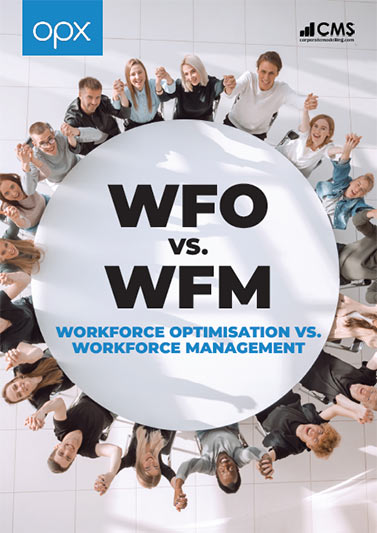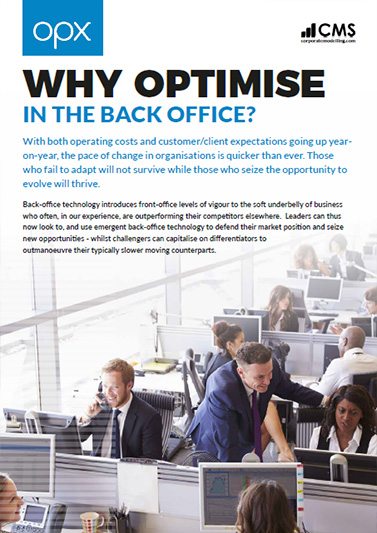What is Workforce Management?
Workforce Management software, often referred to as Back Office Workforce Optimisation (BOWFO), or WFM system, focus on monitoring and management as a means of increasing productivity rather than the organisational IT re-engineering (and building new core systems with embedded workflow processes).

Workforce Management software provides operational intelligence on what’s going on where, and who is doing it, with which systems, and can be used to identify where people are underperforming or where there are major resource shortages or surpluses or system bottlenecks. This is often a great way of spotting areas that need further re-engineering, providing the business data required for the business case of the larger, longer running re-engineering projects.
Workforce Management software understands the processes but, unlike workflow systems, is often looking at a higher level – a Workforce Management software (WFM) is not implementing the back-end system. It is usually interested in the hand-offs of a case (or sequential tasks) at a high level. For example, in a WFM system, changing the address may be a task that takes eleven minutes. In the back-office system, this may involve several screens or applications which an embedded workflow system would have drawn out the process steps and implemented. This is of less interest for optimisation unless the eleven minutes is an issue.
Why should you choose a Workforce Management system?
Other types of solutions, such as workflow systems, tend to provide information based on activities at a granular level, such as the number of new cases per process being started and can often report on each activity, including who has completed the work. Workflow systems rarely do this with regards to customers, products, service level agreements, skills required or skills available, except for the permission skills in the processes or activity.

The WFM solutions fill this gap. Workforce Management software focuses on more comprehensive, real-time data, such as:
- backlog work in the queues
- new work being added by a source
- rework
- the time taken to process a case by each person/robot before handing off
- the quality outcomes for a team or individual
- skills required for the demand coming in
- skills available (human capacity)
- resources available
- productivity, utilisation, efficiency
The Workforce Management system manages cases through processes and routing these cases by business rules. A Workforce Management system concentrates on the demand and the resources placed on operations looking at the people and processes in a different manner.
The operations team can manage, change, and enhance WFM systems with little or no IT involvement. The same cannot be said for workflow products.
How does a Workforce Management software work?
WFM systems answer operational questions using cold hard facts about who is doing what, and where and when they do it. This gives an Operational Insight to the management. WFM offers the same case management tracking type features at a much lower level of detail and provides operational perspectives on more granular data.
What are your employees doing?
WFM systems record a person from the minute they get to the office until the time they leave, identifying everything the person has been involved in, including meetings and non-transactional work. Other types of systems tend only to handle transactions and so for example, miss idle-time where the person was not on a break and not working on business activities.

WFM software also usually provide dashboards showing what’s happening in real-time and allow previewing what an individual has been doing and what they are currently working on. This is invaluable for tuning the automated work allocation systems when business demand changes quickly.
To compare, other types of systems are often case centric. For example, they are limited to providing you with information on the cases an employee has worked on rather than providing the full picture of what the employee has done all day.
How do you get the right people for the work?
Workforce Management systems can tell you the demand they have processed, both transactional and non-transactional. WFM excels in displaying the skills in relation to the process activities.
WFM systems drill this down and break up this work into skill keys. Skill keys look at the data in the individual piece of work and then look at the skills an employee has before allocating the work to them. For example, although there may be a claims validation check in the process, it could be that certain products need unique skills, either in the product or the back-office system administrating the product. In other systems, such as workflow, allocated cases can be returned because the user assigned to the case did not have the skills.
Breaking the work demand queues into smaller sets allows you to see many operational insights, such as “how many people do I have that can process Product X or Platform Y?”; invaluable when used with capacity planning and workforce scheduling.
Skills are fungible. WFM systems usually have skill matrices, and skills have competency levels often maintained by doing the work. In a WFM system, people can go from trainee to expert by doing the cases and passing the QA.
Have I got the right people right now?
Business is about getting work done in a timely and cost-effective manner. WFM solution not only allocates the work to individuals in real-time, but it can also track and monitor SLA’s, identify hot spots, determine which individuals in your team could be re-allocated to help and identify which individuals in the whole company could be drafted in to help in a hotspot situation; and of course provide visualisations.
In a workforce management system, moving work from one department to another, from one site to another or from one country to another takes only a minute or two. Adding a person in a different team/site/country to help with your backlog due to their skills takes seconds (with their manager’s permissions). They can even do both managers workload prioritising their home work over their away work.
Have I got the right people going forward?
Workforce management software thinks big data. They record as much data as often as they can at as low a level as possible, providing the ability to take these data points and analyse them as required. One use is for capacity planning.
WFM systems often have modelling capability inside the system. In our case, we use a spreadsheet metaphor (not Excel, although you can use this if you want), which allows models to build on historical or projected data and get raw or summarised data as needed. Using this approach, the assumptions can be varied, allowing a what-if approach to modelling capacity and forecasting.
Using actual (as opposed to estimated) average handling times for a process, we can predict the headcount required per day, week, month, quarter and year as required. The inbuilt modelling system can use costs or other data exported or interfaced into Excel to produce target operating models.
Workforce Management systems also often provide Robotics Process Automation (RPA) and treat robots like humans, giving them skills and tracking average handling times. For example, in OPX, you might decide that claims under £5,000 are processed automatically by robots, with only data exceptions being handled by humans, while claims over £5,000 are always processed by a human. You may vary this by book of business or plan.
How can a workforce management software support business operations?
WFM’s can help with blended operations providing:
- Identification and verification systems (ID&V)
- Complaints and voice of dissatisfaction processing
- “One & done” recording in the front-office with seamless handover to back-office
- Ensure higher utilisation in the front-office by operators handling simple back-office work items
- Script-based solutions allowing back-office staff to handle call quality
- Workforce team scheduling, handling multiple working shifts, shift rota, holidays.
And, for example, help with process adherence and quality:
- Scripting of customer interactions
- Scripting or robotic interactions via portals, SMS or email
- Checklists at every required stage or processing
- Quality assurance using open and closed QA activities, sampling and reporting.
- Automated escalation
Furthermore, assisting with compliance teams work:
- Full audit trail of interactions
- Financial Ombudsman Services (FOS) reporting solutions
- Treating Customers Fairly (TCF) data reporting solutions
- Conduct risk-related data and reporting systems
Are you interested in an award-winning WFM system demo? Contact us!


 Thank you for your interest in our whitepaper. You can download Workforce Optimisation vs Workforce Management by clicking the button below.
Thank you for your interest in our whitepaper. You can download Workforce Optimisation vs Workforce Management by clicking the button below. Thank you for your interest in our case study. You can download the HCL IBS Case Study by clicking the button below.
Thank you for your interest in our case study. You can download the HCL IBS Case Study by clicking the button below. Thank you for your interest in our case study. You can download the ReAssure Case Study by clicking the button below.
Thank you for your interest in our case study. You can download the ReAssure Case Study by clicking the button below. Thank you for your interest in our case study. You can download the Student Loans Case Study by clicking the button below.
Thank you for your interest in our case study. You can download the Student Loans Case Study by clicking the button below. Thank you for your interest in our case study. You can download the Principality Building Society Case Study by clicking the button below.
Thank you for your interest in our case study. You can download the Principality Building Society Case Study by clicking the button below. Thank you for your interest in our whitepaper. You can download WorkFlow vs WorkForce Management by clicking the button below.
Thank you for your interest in our whitepaper. You can download WorkFlow vs WorkForce Management by clicking the button below. Thank you for your interest in our whitepaper. You can download Homeworking in Financial Services Operations by clicking the button below.
Thank you for your interest in our whitepaper. You can download Homeworking in Financial Services Operations by clicking the button below. Thank you for your interest in our whitepaper. You can download Workforce Optimisation for the Back Office by clicking the button below.
Thank you for your interest in our whitepaper. You can download Workforce Optimisation for the Back Office by clicking the button below. Thank you for your interest in our whitepaper. You can download Operational Workforce Management: Build or Buy? by clicking the button below.
Thank you for your interest in our whitepaper. You can download Operational Workforce Management: Build or Buy? by clicking the button below. Thank you for your interest in our whitepaper. You can download Homeworking & Back Office Workforce Optimisation by clicking the button below.
Thank you for your interest in our whitepaper. You can download Homeworking & Back Office Workforce Optimisation by clicking the button below. Thank you for your interest in our whitepaper. You can download Why Optimise in the Back Office? by clicking the button below.
Thank you for your interest in our whitepaper. You can download Why Optimise in the Back Office? by clicking the button below.